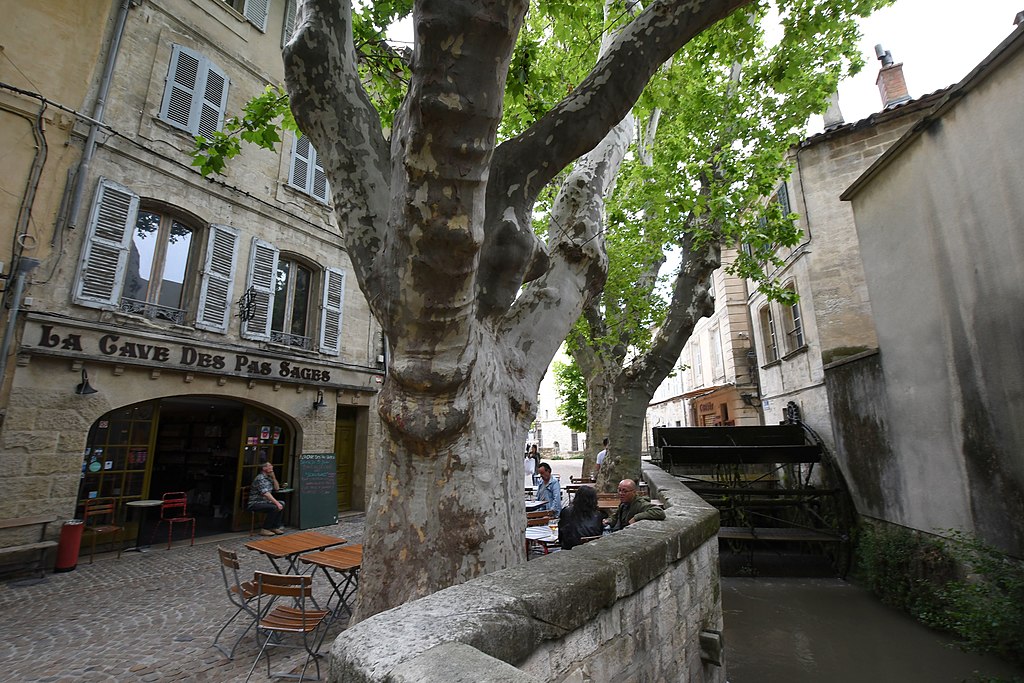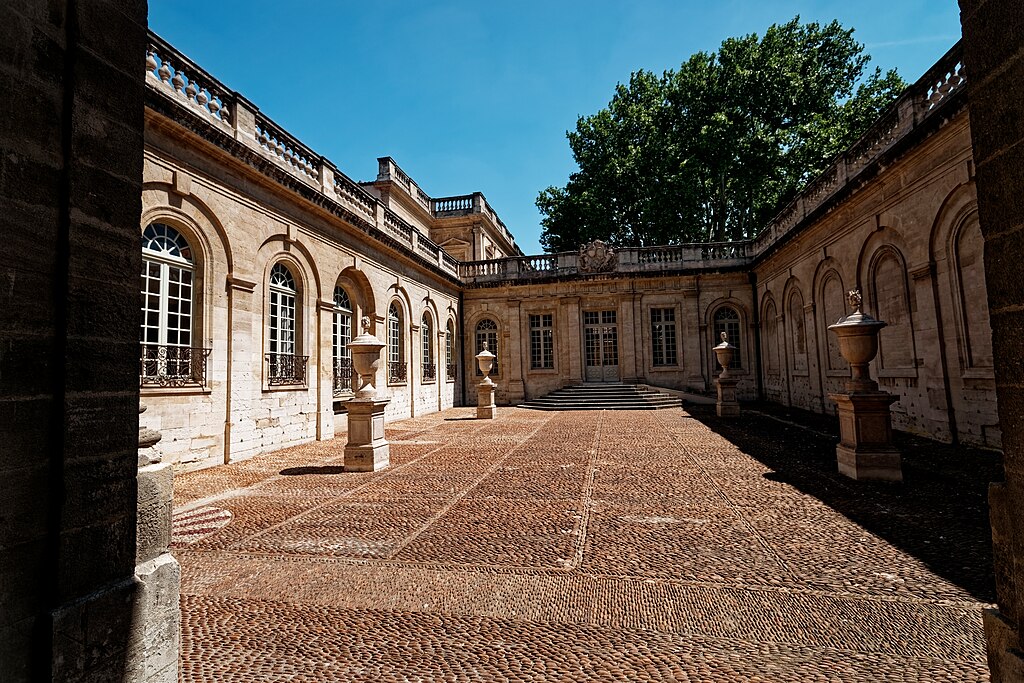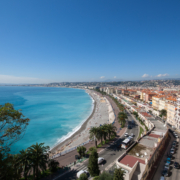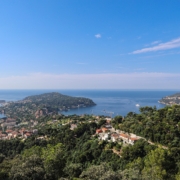Avignon does not reveal itself immediately. It does not strike you with spectacular panoramas like Paris, nor does it entice you with postcard views like the lavender of Provence. Here, everything is different: behind the stone walls lies the story of how Rome lost the Popes, the bridge leads nowhere, and the best doors in the city are not the main ones at all.
» READ MORE – 10 delicious dishes to try in Provence
To help you navigate these layers, we have prepared an audio guide. In addition, you can take advantage of our other routes through France with a discount using the promo code PARIS10. In the meantime, here is your quick guide: the sights of Avignon that are really worth seeing!
Symbols of Avignon: things you can’t leave without seeing
These sights of Avignon have become its calling card – recognisable, powerful and even theatrical. They are a good place to start your acquaintance with the city, even if you are short on time. They require no effort – just attention and a few steps on foot.
Avignon Bridge (Pont Saint-Bénézet)
The Saint-Bénézet Bridge is perhaps the most famous symbol of the city. According to legend, a simple shepherd began building it in the 12th century, claiming that it was a divine command. It became one of the key crossings over the Rhone in southern France, connecting Avignon with the roads of Provence. Of the 22 arches, only four remain, along with the Chapel of Saint Nicholas. However, the bridge became famous thanks to a children’s song and now features in almost every tourist photo.
A great way to see the bridge is to take a walk along the river. At the boat station under the bridge, you can rent a boat or take a free ferry to Bartelas Island.
» READ MORE – The Most Beautiful Places in Provence
Papal Palace
When Avignon became the centre of Catholic Europe in the 14th century, a true Gothic giant rose here.
This period went down in history as the Avignon Papacy – from 1309 to 1377, the Popes ruled the Catholic Church not from Rome, but from here, in Avignon. «Captivity» is more of a political expression: the Popes were not arrested, but were under the strong influence of the French crown. At that time, Avignon formally belonged to the Neapolitan crown but was controlled by France.
It was during this period that the Papal Palace was built – a grand complex combining the features of a fortress, a palace and a cathedral. Over the course of twenty years, towers, ramparts and halls were erected here, and tourists from all over the world have flocked here ever since.
Inside, there are painted walls, frescoes, stained glass windows, and the Pope’s chambers with paintings by Matteo Giovanetti. In the summer, the palace hosts a famous theatre festival, one of the most important in Europe. It brings together troupes and audiences from all over the world: performances are staged in the open air, in the courtyard and in city venues.
Notre-Dame des Doms Cathedral
Next to the Papal Palace, this cathedral seems modest, but inside it has its own character. The spacious and light Romanesque style, frescoes, the tomb of Pope John XXII and the ancient altar create an atmosphere of peace. On the roof is a gilded statue of the Virgin Mary with her arms outstretched over the city.
Rocher des Doms Garden
If you want to see Avignon from above, climb up to the garden on the Rocher des Doms rock. The panorama is magnificent – the river, the bridge, the village on the other bank. The park itself is well-kept and shady, with artificial grottoes, a small waterfall, a playground and alleys. It was first developed in the 19th century as a romantic spot, and it still retains that atmosphere today. It is an excellent place for a walk and a break from the hustle and bustle of the city.
Avignon has many parks and squares – take a look at the Dom Park, the Checcano Garden or the Petramal Park.
Medieval appearance: walls, churches and old streets
The streets of Avignon remember not only the Popes, but also craftsmen, monks, merchants and tourists long before selfie sticks. Everything here is authentic: the gates through which lifting chains clattered, the carved doors over which people bowed their heads. These sights of Avignon are not on postcards – they are in the details that are easy to miss if you rush by.
» READ MORE – Bike trip around Provence
The city walls and gates of Avignon
Today, the fortress walls of Avignon embrace the old centre, just as they did in the Middle Ages. When the popes settled here, the city urgently needed protection, and a powerful defensive belt began to be built in stages. The work took several decades, and the result was an almost completely preserved ensemble with 14 gates.
Among them, the Porte de la République and the Porte du Rhône stand out – they are easily recognisable and accessible for walking. Walking around part of the wall is a great opportunity to imagine what the city was like in those days.
Église Saint-Agricol
The oldest parish church in Avignon with a Gothic interior and beautiful stained glass windows from the 13th–14th centuries. Inside, there is light and restrained decor without excess, a carved altar, stone arches and vaults.
The church often remains in the shadow of others, but it deserves attention, especially if you are interested in the history of the city.
Saint-Pierre Church
Saint-Pierre is a Gothic church with one of the most beautiful carved doors in Provence. Inside, there is an organ, stained glass windows and carved choir stalls. The façade is decorated with exquisite stonework, and the atmosphere remains intimate and peaceful.
Please note that the church is not open every day – it is best to check the opening hours in advance before visiting.
Rue des Teinturiers
Teinturiers is Avignon in miniature: narrow, paved with pebbles, with a canal along which old wheels still turn. Once upon a time, the textile industry flourished here, but today you can see unusual shops, old houses and the mysterious «house with four» with incomprehensible symbols on the façade.
Here, too, is the tower of a ruined monastery where Laura, the woman to whom Petrarch dedicated his famous sonnets, is buried.
Place de l’Horloge
The city’s main square is shaded by plane trees. Here you will find the town hall, the theatre and the tower with the clock, which strikes the hour with life-size figures. It is a good place to take a break and have a coffee.
Right under the plane trees, there is an old two-storey carousel. It is decorated with lights, horses and vintage carriages that are hard to take your eyes off. Both adults and children take photos here – it’s impossible to leave without snapping a picture.
Museums for a rainy day and more
When the streets are scorched by the sun or you want to slow down, Avignon’s museums reveal their full potential. Here you will find 14th-century Italian paintings, Egyptian artefacts and an unexpected encounter with Van Gogh. These are not the most famous attractions in Avignon, but it is often here that you experience that «wow effect», especially if you go in without any expectations.
Avignon City Pass: tourist cardMusée du Petit Palais
Once home to bishops, now home to masterpieces of painting. The Petit Palais has an impressive collection of Italian Renaissance, medieval sculpture and proto-Renaissance painting from the 14th–15th centuries, which is rarely found in other museums in France. Among other things, it features Botticelli’s «Madonna and Child».
Admission is free, and there is a café in the courtyard – a great place to take a break.
Musée Calvet
Another museum with an eclectic collection: from ancient sculptures and Spanish paintings to Egyptian artefacts, medals, weapons and 19th-century curiosities. The museum was founded according to the will of Jean-Baptiste Calvet, a doctor and collector who donated his collection to the city in the early 19th century. This is not an ordinary art gallery, but a real mixture of eras and cultures – you will especially enjoy looking at rare items. The Egyptian collection here is, of course, more modest than in the Louvre, but for a city of this size, it is a real find.
Lapidaire Museum
If you are already familiar with cathedrals and palaces, take a look at the Lapidaire, a branch of the Calvet Museum hidden in a former Jesuit college. Inside, it is not a gallery but a real stone hall: columns, sarcophagi, antique heads, Roman bas-reliefs. All this is not behind glass, but close by, within arm’s reach.
The room is dimly lit, and the sounds are muffled by the stone walls – it’s like being in a temple of antiquities. Those who love antiquity and a little mysterious silence will especially enjoy it. There are few visitors, and the exhibition feels almost private.
Angladon Museum (Collection Angladon)
A private collection in the centre of Avignon. The main exhibit is a Van Gogh painting, the only one in the city that is really worth queuing for. The rest of the exhibition is a pleasant collection of Picasso, Degas, Manet and others, plus antique furniture arranged by era. Suitable for those who are not planning a trip to Arles or the Orsay Museum.
Les Halles d’Avignon – a covered market with a living wall
Among the sights of Avignon, there are some where you can taste Provence – literally. Start your morning with coffee by the truffle baskets – that’s how they greet the day at Les Halles market. Behind the glass doors are dozens of stalls: local cheeses, olives, snails, fresh baguettes, sausages and sweets. Outside, there is a vertical garden on the façade, and inside, there is a living cross-section of Provençal gastronomy. It is best to come early, when the chefs are shopping and the air smells of herbs and bread.
Sights outside the city centre
When you have explored the city from top to bottom and are looking for peace and quiet, it is time to venture outside the city limits. There are many places where history is not confined to museums but can be found right under the open sky. These are also attractions of Avignon, even if they are not officially listed.
One-day tour «The Best of Provence»Chartreuse de Villeneuve-lès-Avignon
If you want peace and quiet and almost monastic tranquillity, cross the bridge to Villeneuve-lès-Avignon. There, in the shade of ancient trees, lies the Chartreuse, a former Carthusian monastery with gardens, frescoes and an atmosphere of seclusion from the hustle and bustle. It is only a 15-minute walk from the Papal Palace, but almost no one comes here – and that’s a shame.
The monastery was founded in the 14th century by Pope Innocent VI. Behind its high walls are cloisters, cells, chapels, romantic ruins and well-kept courtyards. The interiors are austere, without unnecessary decoration, but with frescoes and painted vaults that have survived to this day. In summer, art residencies and exhibitions are held here, but even without them, a walk through Chartreuse is a journey through time. Sit down on a bench, close your eyes – and you are already in the 14th century.
Pont du Gard Aqueduct
Pont du Gard is an ancient Roman aqueduct in excellent condition in a picturesque location. Built by the Romans without a single gram of cement, its three levels of arches still look impressive. It is especially nice to walk here in the early morning or at sunset, when there are fewer tourists.
Ticket to Pont du GardIf you are travelling by car, the journey takes about 30 minutes. Without a car, the easiest way to get there is with a tour, and there are many options available.
Avignon does not require enthusiasm – it remains calm, like a city that knows its worth. Even in summer, when the festival begins and the streets are filled with decorations and people, it does not lose its character. So even if you have seen all the sights of Avignon, don’t rush to leave. The most interesting things here are often not on the list, but on a bench by the fountain or in a conversation with a lavender seller.
» READ MORE – Provence’s lavender fields











 Jp Valery / Unsplash
Jp Valery / Unsplash 
 Fabien / Pixabay
Fabien / Pixabay 

 Spenser Sembrat / Unsplash
Spenser Sembrat / Unsplash Dimitris Vetsikas / Pixabay
Dimitris Vetsikas / Pixabay
Leave a Reply
Want to join the discussion?Feel free to contribute!